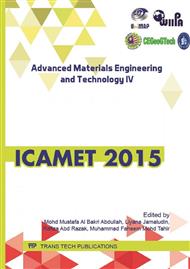p.87
p.93
p.101
p.106
p.111
p.116
p.121
p.126
p.131
Microwave Irradiation Assisted Synthesis of Silicon Carbide Nanotubes
Abstract:
Conventional methods for the synthesis of silicon carbide were well studied and these methods included carbothermal reduction, mechanical milling, sol-gel process and others. However, conventional methods have limitations such as high energy consumption, presence of impurities and long reaction times. In this paper, microwave heating was applied for the first time for the synthesis of silicon carbide nanotube owing to the advantages of microwave heating such as shorter reaction time, uniform heat distribution and low cost. Mixture of silicon dioxide and carbon nanotube in the ratio of 1:3 as suggested by previous study were mixed in ultrasonic bath using ethanol as liquid medium for 2 hours and then dried on hot plate to evaporate ethanol. The mixture was then cold pressed into 3mm pellet and placed into an alumina crucible filled with silica sand acts as sand insulator and SiC susceptor. The pellet was heated to 1400°C with heating rate of 30°C/min for 40 minute. X-ray diffraction pattern verified the presence of single β-SiC phase in silicon carbide nanotubes. Meanwhile, scanning electron microscopy revealed that tubular structure of carbon nanotube was retained after microwave irradiation and energy dispersive x-ray spectroscopy shown the silicon carbide nanotube consist of only elemental C and Si and thus indicated that silicon carbide nanotubes were successfully synthesized through microwave irradiation.
Info:
Periodical:
Pages:
111-115
Citation:
Online since:
May 2016
Price:
Сopyright:
© 2016 Trans Tech Publications Ltd. All Rights Reserved
Share:
Citation:


